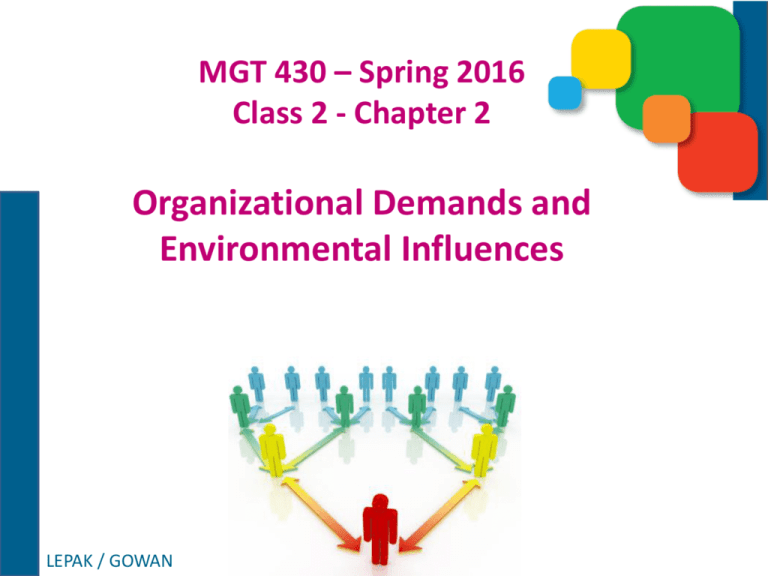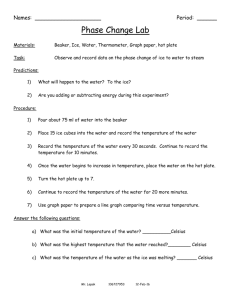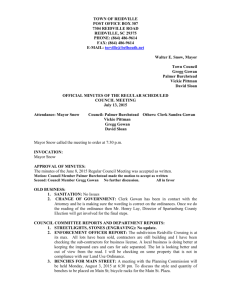Class 2
advertisement

MGT 430 – Spring 2016 Class 2 - Chapter 2 Organizational Demands and Environmental Influences LEPAK / GOWAN Syllabus Discussion Topics 1. 2. 3. 4. Form teams Elect officers for 1st term (Jan 20 – Mar 15) Essays Presentations LEPAK / GOWAN BASIC BUSINESS 101 INCREASE REVENUE LOWER COSTS LEPAK / GOWAN HR LEPAK / GOWAN Business Strategy A set of integrated and coordinated commitments and actions intended to achieve stated business goals. Strategy answers the questions: • • • • What is our business? Who is the customer? What is the value to the customer? What should (or can) our business be? LEPAK / GOWAN Company Characteristics • Size Large – medium- small; one division – multiple divisions • Resources available Plenty vs. limited; domestic vs. global • Company life cycle stage Introduction – Growth – Maturity - Decline • Company success LEPAK / GOWAN Organizational Culture The mental programing of a group of people. It is comprised of the values, customs, and belief systems of that particular group Impacted by: Industry Geography Age Diversity History LEPAK / GOWAN (banking vs. construction) (Miami vs. San Francisco vs. Cairo) (Millenials vs. Ba=by-Boomers) (Race vs. ethnic vs. age vs. income) (Home-grown vs. start-up) Company Culture • The unique pattern of shared assumptions, values, and norms that shape the socialization activities, language, symbols, and ceremonies of people in the organization, e.g. • banking vs. construction • teaching vs. retail sales • accounting vs. R&D LEPAK / GOWAN Employee Concerns Some issues: • Single parents; caring for aging parents • Dual career; balancing demands of work and personal lives • Attractiveness of flexible scheduling, family-friendly benefits and telecommuting Some Topics of Interest • Work/Life Balance • Justice/Fairness • Engagement/Commitment LEPAK / GOWAN LEPAK / GOWAN Labor Force Trends • Diversity in race, gender and age • Number of women expected to grow 9% from 2006 to 2016 • Fastest-growing groups: Hispanics and Asians • Aging of the workforce - Size of group 55 and older increasing dramatically • Occupational trends LEPAK / GOWAN Technology • Factories and mass production • HRIS & QR • Reducing labor costs vs. acceding to consumer demand for electronic transactions, e.g. ATM, QR apps, self-checkout • Challenges privacy issues and potential misuse by employees • Reach – Broadens access to labor market – Enables virtual workforce LEPAK / GOWAN Globalization • Blurs country boundaries • Enables international joint ventures and partnerships • Challenges companies with differences in values and beliefs • Encourages offshoring—sending work to other countries for lower costs LEPAK / GOWAN Ethics and Social Responsibility • Companies and their management being held accountable for ethical behavior • Corporate policies and procedures spell out ethical behavior • Social responsibility takes ethics to a new level LEPAK / GOWAN HRM MARKET FOCUS STRATEGY CONSIDERATIONS Low cost Zales vs. Tiffany Motel 6 vs. Ritz-Carlton Differentiation Sears vs. Brooks Brothers Rolls-Royce vs. Hyundai Niche Antique car parts vs. AutoZone/Pepboys LEPAK / GOWAN Changes in the Labor Force Aging Workforce Diverse Workforce Skill Deficiencies AGE DISTRIBUTION OF U.S LABOR FORCE, 2010 AND 2020 HRM Implications of an Aging Workforce • HR professionals spend much time on concerns related to retirement planning, retraining older workers, and motivating workers whose careers have reached a plateau. • Organizations struggle to control rising costs of health care and other benefits. • Managers will supervise employees much older than themselves. • Organizations must find ways to attract, retain, and prepare youth labor force. Skill Deficiencies of the Workforce • Employers are looking for skills: mathematical verbal interpersonal Computer STEM Science Technology Engineering Math Skill Deficiencies in HRM • Silo mentality • Knowing how the company makes money • Basic, but strong, understanding of business finance • Enhanced business acumen • Linking HR work to the critical decision making factors demanded by TMT • Making a business case for HRM initiatives. LEPAK / GOWAN HR As A Strategic Partner Earning a Seat at the Decision Making Table • • • • • • • Credibility Business & financial intelligence Competitive intelligence Forecasting future needs Talent management Transactional perfection and efficiency Helping other functions succeed • Linking HRM to performance drivers of TMT LEPAK / GOWAN Strategic Alignment of HRM Performance Metrics HR Metrics Corporate Metrics Talent management Turnover/retention Benefits Labor Compensation Compliance – EEO / AAP Training & development Value-added outcomes Shareholder value Profitability / solvency Cost controls Market share Mission, vision, values Performance ratios LEPAK / GOWAN HR as a Strategic Partner Core Transactional & Strategic H.R. Deliverables DIRECT/INDIRECT LINE OF SIGHT • • • • • Increase revenue / decrease costs Advance the objectives of the organization Improve profitability & productivity Generate competitive advantages Keep the company in business • Other??? LEPAK / GOWAN TMT PROD HR FIN M&S LOG Line of sight Customers Owners Community LEPAK / GOWAN Gov’t Environment R&D HR Challenge Question Production department problem Average monthly defect rate Actual 5/100 = 5% Acceptable 3/100 = 3% 1. Who owns this problem? Production? HR? Purchasing? 2. Goal 1/100 = 1% Other? How does HR impact these numbers? LEPAK / GOWAN Potential HR Responses • Production owns the problem • HRM provides problem solving assistance, e.g. Adequate staffing Employee motivation Goal setting Other LEPAK / GOWAN Training Compensation Job analysis Possible HRM Responses HRM partners with TMT to address these issues along with partners from other disciplines Staffing Leadership Job analysis Performance mgmt. LEPAK / GOWAN Scheduling Job descriptions Technology Customer response Linking HR Activities To Corporate Financial Performance (Direct & Indirect) • • • • • • Health/pension liab. Employee/labor costs Outsourcing, TPA Training costs FMLA Other ??? LEPAK / GOWAN $$$ $$$ $$$ $$$ $$$ $$$ H.R.I.S Layoffs Legal defense Compliance Mandatory ins. Part time/Temp. HR’s Impact on Income Statements Income Statement • Revenue minus Expenses • $10 - $7 • Profit margin (3/10) = Net income / net loss = $3 = 30% Cost of Goods Sold Headcount Wages paid to employees (e.g. labor contracts) Expenses e.g. Selling, general & administrative expenses Fringe benefits – e.g. vacation, holidays, sick leave LEPAK / GOWAN HR Calculations 1. Revenue generated per employee Revenue / # FTE Employees $82,364,000/249 = $330,779 HR Linkage (cut 25 jobs) = $82,364,000 / (249-25 or 224) = $367,696 = $367,696 - $330,779 = $36,917 (10%) increase/employee 2. Benefit costs as % of revenue (40% of payroll) Benefit costs / revenue $14,825,000/$82,364,000 = 17.9% HR linkage - National health care increase = $2 million $16,825,000 / $82,364,000 = 20.4% LEPAK / GOWAN More H.R. Calculations 4. Workers Compensation costs per covered employee W.C. costs / # covered employees Current: $190,045 / 249 = $763 Worse safety $223,529 / 249 = $898 Better safety: $154,676 / 249 = $621 6. Turnover ratio (@150% of salary) Annual # turnover / average # employees Current: 17 /249 = 6.8% Worse: 21 / 249 = 8.4% Better: 11 / 249 = 4.4% LEPAK / GOWAN HR Impact on Financial Condition Option 1: Raise revenue - Improve training and its deliverables - Partner with other functions to discover opportunities for productivity and profitability improvements - Define measureable and relevant outcomes across disciplines (job descriptions) - Enter new markets (awareness of labor costs) - Exit non-productive markets (facility closing costs) - Intensify focus on 80/20 customers (Pareto’s Law) LEPAK / GOWAN HR Impact on Financial Conditions Option 2: - Lower costs Reduce headcount Outsource/off-shore Evaluate third-party administration Employ technology (H.R.I.S.) Aggressive management of health care & pension costs Cost vs. benefit analysis Part time/temporary employees LEPAK / GOWAN Suggested HR Metrics Turnover ratios Cost per hire Benefit costs Worker’s Comp. Recruiting costs Outsourcing H.R.I.S. LEPAK / GOWAN Compliance Training costs Payroll costs Unemployment e-learning Labor relations




![[Name] - Sociology](http://s3.studylib.net/store/data/007450646_1-0c09054e2e24296a8374dd2c1b7193b4-300x300.png)

